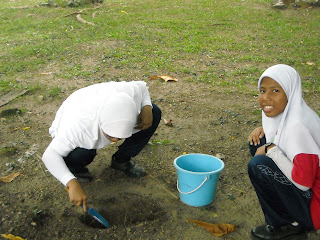What is compost exactly? Well, compost is a mixture of decaying vegetation and manure; used as fertilisers. Why should you make compost? Compost contributes to the reduction of global wastage.
Instead of throwing out those left-overs after dinner, why not make compost? It's a simple task and does not need big budgets. You may ask what can I change by making compost? You may be one person but every change starts one by one. Imagine a world where everybody contributes to the reduction of global wastage by making compost. Think of the many things we can change. To make your own compost is very easy and only takes you 6 steps. Follow the steps below to learn and make your own compost in your own backyard.
1. Prepare a container with holes and the necessary things such as water, waste and soil.
2. Seperate the waste that is suitable for compost (vegetables and fruits; not bananas and
oranges).
3. Chop the waste into small bits and pieces to allow the decomposition process to perform faster.
4. Mix the waste and the soil together into the container.
5. Mix a bit of water to make sure the compost is moisture.
6. Leave the compost aside in a hot and humid area and cover the top to avoid rain water from
going in.
Compost may be an easy thing to make but requires a long time to mature; about six months, and needs a whole lot of attention. Tender, love and care. Remember, worms play a big part in your compost. They help and also allow the decomposition process to take place. Always check on the degree of moisture and turn the soil daily.
A good compost will turn brown and earth-like colour. It will not smell and will look very much like the soil we started with.
Why not get started today? Play your part in saving and protecting the earth that we love. You can make a difference.

 Aziemah and Sarah digging soil from the surrounding area to be added and mixed with the chopped waste.
Aziemah and Sarah digging soil from the surrounding area to be added and mixed with the chopped waste.






